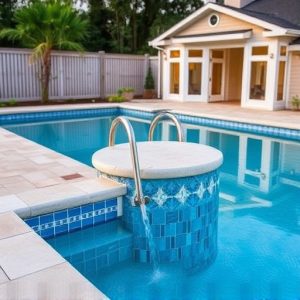Securing Your Inground Pool: A Guide to Swimming Pool Alarm Systems
Swimming pool alarms for inground pools are critical for enhancing safety and complying with regula…….
Swimming pool alarms for inground pools are critical for enhancing safety and complying with regulations. These alarms can issue audible signals or remote notifications when detecting unauthorized or accidental entries into the pool area. They serve as a vital complement to physical barriers, aiding in the prevention of drowning incidents, particularly for children who are at high risk. Users have various types of swimming pool alarms to choose from, including magnetic beam systems, surface wave detectors, and pressure-based sensor arrays, each tailored to specific security needs. Integrating these alarms into broader home security systems is recommended for a multi-faceted approach to pool safety. Regular maintenance, testing, and updates are essential to ensure the alarms function correctly under all conditions. Beyond compliance, safety experts advise incorporating visual warnings and linking alarms with a comprehensive home security system for optimal protection. By adhering to these practices, property owners can provide a secure environment and peace of mind for their inground pools.
Swimming pool alarms for inground pools serve as a critical safety measure, safeguarding against unauthorized access and drowning incidents. This article delves into the essential aspects of integrating such systems into your pool security plan. We will explore the types of alarms suitable for inground pools, installation best practices, maintenance strategies to keep your system operational, and the legal requirements that ensure compliance with safety standards. A well-implemented swimming pool alarm system can provide peace of mind and enhance the overall safety of your aquatic environment.
Understanding the Importance of Swimming Pool Alarms for Inground Pools
Swimming pool alarms for inground pools serve as a critical safety measure that can significantly enhance the security of your aquatic facility. These alarms are designed to detect unauthorized or accidental entries into the pool area, alerting homeowners or lifeguards immediately with an audible signal or remote notification. Given the depth and potential for drowning incidents, which remain a leading cause of unintentional death in children, the installation of these alarms can provide peace of mind and an additional layer of defense against such tragedies. It’s not just about compliance with safety regulations; it’s about integrating technology that actively monitors the perimeter of inground pools to ensure that only authorized individuals have access when a pool is unattended or during off-hours. By choosing from a variety of swimming pool alarms for inground pools, property owners can customize their security system to fit their specific needs, whether it’s a magnetic beam system, a surface wave detector, or a pressure-based sensor array. These systems are often user-friendly and can be easily integrated into an existing home security setup, providing comprehensive monitoring that extends beyond the visual supervision of pool areas.
Types of Swimming Pool Alarms: Finding the Right Fit for Your Inground Pool
When securing your inground pool, investing in a reliable swimming pool alarm is a prudent step to enhance safety and peace of mind. Swimming pool alarms for inground pools come in various types, each designed to address specific security needs. Surface motion detectors, which are sensitive to movement on the water’s surface, can be particularly effective for inground pools. They are triggered by any unauthorized disturbance, alerting homeowners to potential safety breaches in real-time. Another option is a pressure-based alarm system that monitors changes in water pressure, signaling an exit or entry from the pool. These systems are installed underwater and can detect even the smallest shifts caused by someone getting out or falling into the pool.
For inground pool owners, it’s crucial to consider the design and layout of their pool when selecting a swimming pool alarm. Factors such as the pool’s size, depth, and location on the property will influence the type of alarm system best suited for your specific situation. Additionally, local regulations may dictate certain requirements for pool alarms, so it’s advisable to research and comply with these before making a purchase. A comprehensive approach involves combining different types of alarms, such as using both surface motion detectors and pressure-based sensors, to create a multi-layered security system. This not only boosts the overall effectiveness of the safety measures but also offers reassurance that your inground pool is adequately protected against unauthorized access.
Installation and Configuration: Best Practices for Swimming Pool Alarm Systems
When installing and configuring alarm systems for inground pools, it’s imperative to adhere to best practices to ensure optimal safety and compliance with local regulations. The first step is selecting a swimming pool alarm that meets your specific needs and complies with the relevant safety standards. These alarms can be either pressure-operated surface wave detectors or motion-triggered devices, which are designed to alert homeowners of unauthorized access to the pool area. Upon installation, it’s crucial to position the sensor at the water’s edge where it can effectively monitor for disturbances caused by an individual entering the pool. Calibration is also a critical aspect of setup; ensure the alarm is sensitive enough to distinguish between routine activity and potential emergencies or unauthorized use. Regular testing and maintenance are non-negotiable to guarantee the swimming pool alarms for inground pools function correctly under all conditions. Verify that battery levels are adequate, and test the system’s audible alarm regularly to confirm it operates as intended. By following these installation and configuration best practices, pool owners can significantly enhance the safety of their inground pools and provide a protective layer of security for swimmers.
Maintenance and Monitoring: Ensuring Your Pool Alarm System Remains Effective
Regular maintenance and diligent monitoring are critical components in maintaining an effective pool alarm system for inground pools, ensuring the safety of swimmers at all times. These systems, designed to detect unauthorized access or potential dangers within the water environment, rely on consistent upkeep to function optimally. It’s imperative to perform routine checks on the physical components of the alarm, such as sensors and wiring, to prevent malfunctions due to wear and tear. Environmental factors like temperature fluctuations can impact system performance, thus regular testing under various conditions is necessary to validate its reliability. Additionally, software or firmware updates for digital alarms should be implemented promptly to address any security vulnerabilities or enhance their capabilities.
Monitoring protocols must also be established and adhered to strictly. This includes designating responsible personnel to oversee the system’s activation and deactivation, as well as to respond immediately to any alarm triggers. Integrating pool alarms with a comprehensive safety plan that includes visible signage, clear emergency procedures, and real-time video surveillance can further bolster security measures. By combining these proactive strategies with regular maintenance, pool owners can significantly reduce the risk of incidents and ensure their inground pool alarms are an effective line of defense against potential accidents or unauthorized use.
Legal Requirements and Recommendations: Compliance and Safety Standards for Pool Alarms
Swimming pool alarms are a critical component of safety systems for inground pools, serving as a line of defense against unauthorized access. Legal requirements for pool security vary by jurisdiction but generally mandate compliance with established safety standards. These standards often include the installation of approved swimming pool alarms that detect motion within the pool area, alerting homeowners or monitoring services to potential intrusions. For instance, alarms must be audible and meet local decibel requirements to ensure they are noticeable both on-site and at a distance, as stipulated by regulations. Additionally, these alarms should be maintained regularly to ensure their functionality and responsiveness, reflecting the seriousness with which legal entities regard pool safety.
Beyond the legal mandates, recommendations for swimming pool alarms extend beyond mere compliance. Safety advocates encourage the use of alarms that feature both audible and visual warnings, catering to a broader range of sensory detection. Furthermore, integrating these alarms with a comprehensive security system, which includes fencing and access controls like gates with child safety locks, further enhances pool area security. It is also advisable to consider alarms that are integrated into a larger home security network, allowing for immediate response in the event of an alarm being triggered. Adhering to both legal requirements and these safety recommendations not only protects swimmers but also offers peace of mind to property owners.


